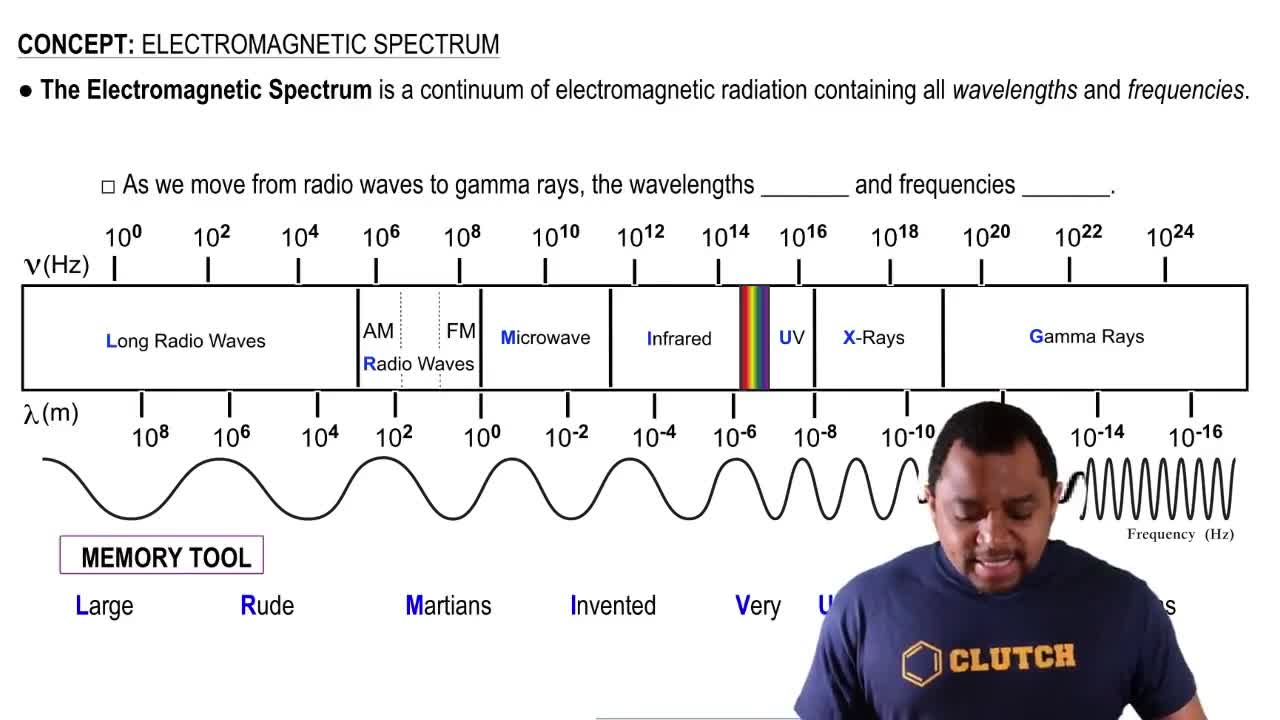Label each of the following statements as true or false. b. Ultraviolet light has longer wavelengths than visible light.
Ch.6 - Electronic Structure of Atoms
Chapter 6, Problem 17
Arrange the following kinds of electromagnetic radiation in order of increasing wavelength: infrared light, green light, red light, radio waves, X rays, ultraviolet light.
 Verified step by step guidance
Verified step by step guidance1
Understand that electromagnetic radiation can be arranged by wavelength, frequency, or energy. Wavelength and frequency are inversely related, while energy is directly related to frequency.
Recall the general order of electromagnetic spectrum from shortest to longest wavelength: gamma rays, X-rays, ultraviolet (UV) light, visible light (violet to red), infrared (IR) light, microwaves, and radio waves.
Identify the given types of radiation: infrared light, green light, red light, radio waves, X-rays, and ultraviolet light.
Place the visible light colors in order of increasing wavelength: green light has a shorter wavelength than red light.
Arrange the given types of radiation in order of increasing wavelength: X-rays, ultraviolet light, green light, red light, infrared light, radio waves.

Verified video answer for a similar problem:
This video solution was recommended by our tutors as helpful for the problem above.
Was this helpful?
Key Concepts
Here are the essential concepts you must grasp in order to answer the question correctly.
Electromagnetic Spectrum
The electromagnetic spectrum encompasses all types of electromagnetic radiation, arranged by wavelength. It ranges from gamma rays with very short wavelengths to radio waves with much longer wavelengths. Understanding this spectrum is crucial for categorizing different types of radiation and their properties.
Recommended video:
Guided course

Electromagnetic Spectrum
Wavelength
Wavelength is the distance between successive peaks of a wave, typically measured in nanometers (nm) for light. In the context of electromagnetic radiation, shorter wavelengths correspond to higher energy and frequency, while longer wavelengths indicate lower energy and frequency. This relationship is fundamental for comparing different types of radiation.
Recommended video:
Guided course

Frequency-Wavelength Relationship
Types of Electromagnetic Radiation
Different types of electromagnetic radiation, such as infrared, visible light (including green and red light), ultraviolet, X-rays, and radio waves, have distinct properties and applications. For example, infrared is used in thermal imaging, while X-rays are utilized in medical imaging. Recognizing these types helps in understanding their arrangement by wavelength.
Recommended video:
Guided course

Electromagnetic Radiation Example
Related Practice
Textbook Question
Textbook Question
Label each of the following statements as true or false. c. X rays travel faster than microwaves.
Textbook Question
Label each of the following statements as true or false. a. The frequency of radiation increases as the wavelength increases. b. Electromagnetic radiation travels through a vacuum at a constant speed, regardless of wavelength. c. Infrared light has higher frequencies than visible light. d. The glow from a fireplace, the energy within a microwave oven, and a foghorn blast are all forms of electromagnetic radiation.
Textbook Question
(a) What is the frequency of radiation that has a wavelength of 10 µm, about the size of a bacterium?
1
views
Textbook Question
(d) What distance does electromagnetic radiation travel in 0.38 ps?
